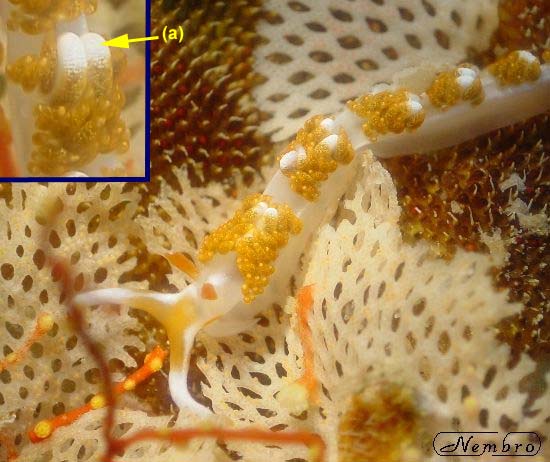This species has been observed on Reunion, Mayotte and Madagascar Islands
The body is translucent with white and orange markings on the head and the tail has a mid-dorsal white streak. The orange rhinophores are not joined at their base. Papillae are present on their posterior surface. The cerata are translucent with the orange brown or grey digestive gland visible and a white to yellow tip. The innermost of each row are larger with the large white ends curled |

|
|
| Showing species characteristics... | Photo Matthias Deuss |
|
Remarks :
Identification confirmed by Nathalie Yonow
Synonymous : (according Worms)
- No other name
Bibliographic data :
The eyes are visible near the base of the rhinophores
The anterior foot corners are prominent, being enlarged into pointed tentacles
The tail is long and the tip is pointed
The oral tentacle are very long and slender with white and orange. Some variation seems to occur between specimens concerning the presence of white pigmentation on the oral tentacles.
In some specimens the rhinophores have a white subapical ring and a vivid dark orange tip
This species bares two forms of cerata, a series of short, more typical cigar shaped cerata at the outer edge of the ceratal bundles, and very long tapering, coiled ones along the inner margin. The cerata are are arranged in six discrete clusters in symmetrical pairs leaving areas of the notum bare
It is the inner cerata that display the pugnacious behavior ( presence of the cnidosac which contains the stinging nematocysts removed from the cnidarian food) when disturbed. When M. brockii is strongly irritated the long cerata near the midline rapidly uncoil and writhe about. Presumaly this behavior presents a threat to predators
Found on shallow water reef where it feeds on hydroids
References :
Bill Rudman Seaslug site : Sea Slug Forum : Moridilla brockii
Nudipixel Moridilla brockii
Publications :
Bergh, L.S.R. (1888) Beïtrage zur Kenntnis der Aeolidiaden. 9. Verhandlungen der Kaiserlich-Koniglichen Zoologisch-Botanischen Gesell-schaft in Wien 38: 673-706, pls 16-20
Rao, K.P. (1965) Moridilla brockii Bergh 1888, redescribed with notes on anatomy and early development. Journal of the Marine Biological Association, India, 7(1) : 61-68
Yonow, N. (1994) Opisthobranchs from the Maldive Islands, including descriptions of seven new species (Mollusca: Gastropoda). Revue fr. Aquariol., 20(4) : 97-130.
Other photos of Moridilla brockii :
Matthias Deuss Mayotte, 14 December 2011. The anterior foot corners (a) are prominent, being enlarged into pointed tentacles The orange rhinophores are not joined at their base. Papillae (b) are present on their posterior surface. The eyes (c) are visible near the base of the rhinophores |
 |
 |
Marina Poddubetskaia Mayotte, Passe en S", bouée n° 2, 7 November 2003, size :28-30 mm The cerata are translucent with the orange brown or grey digestive gland visible and a white to yellow tip. The innermost of each row (a) are larger with the large white ends curled
|
Fabrice Schubert Mayotte, Boueni, 12 m, 14 November 2010 The cerata are are arranged in six discrete clusters in symmetrical pairs leaving areas (a) of the notum bare |
 |
 |
Yvon Gildas Madagascar, Nosy-be Ouest, 12 m, 30 April 2010, size : 80 mm
The cerata are translucent with the orange brown or grey digestive gland visible and a white to yellow tip. The innermost of each row (a) are larger with the large white ends curled The cerata are are arranged in six discrete clusters in symmetrical pairs leaving areas of the notum bare |
Sully Bachel Réunion, Port EDF, 12 m, November 2012, size : < 15 mm In this specimen rhinophores are white opaque (a) and not orange. This rarely variation are also observed in this specimen from Indonesian Papillae are present on the posterior surface of rhinophores |
 |
More photos from Indian Ocean
Mayotte, Moridilla brockii with entire white oral tentacles, by Guillaume Boeye